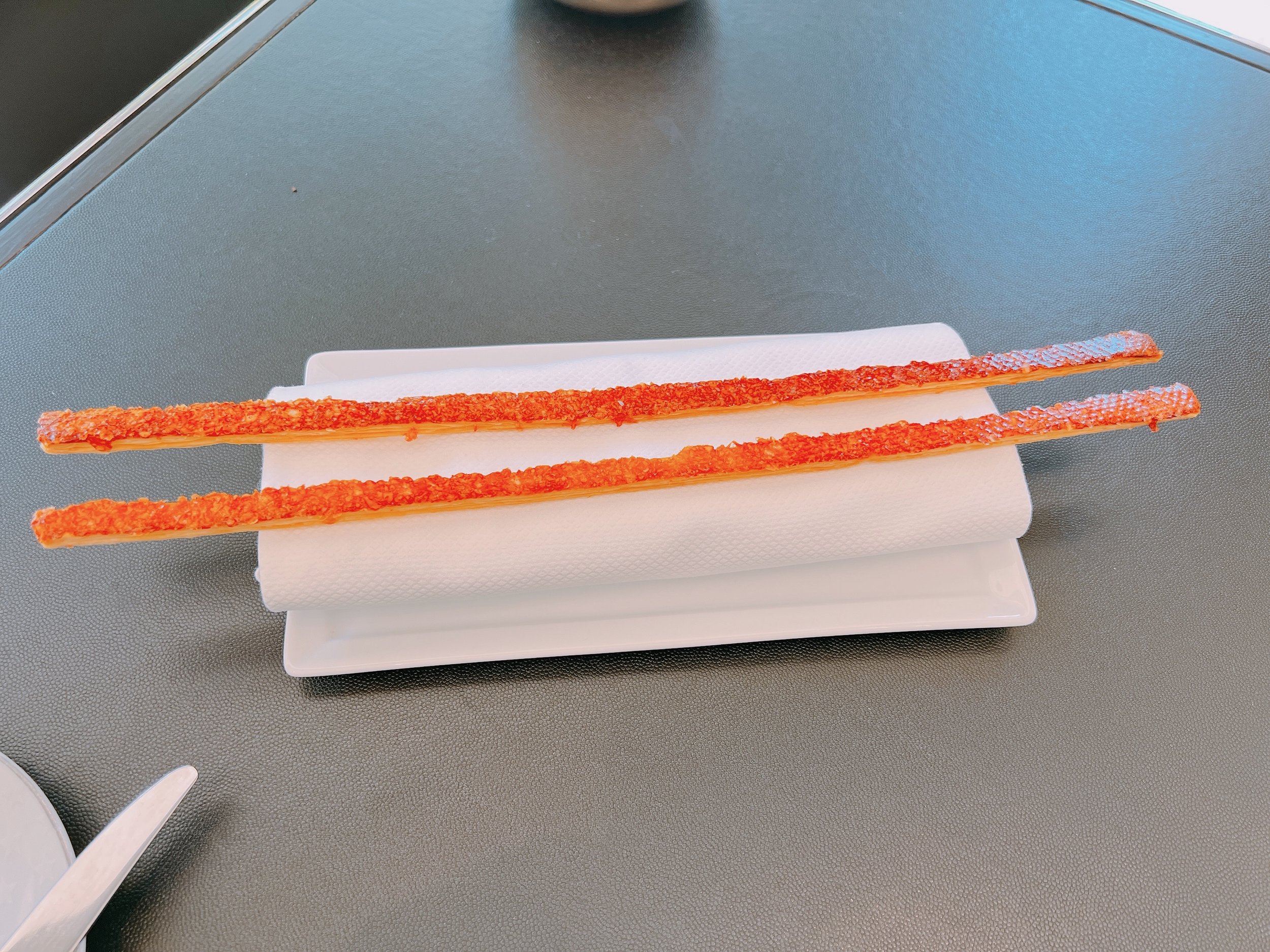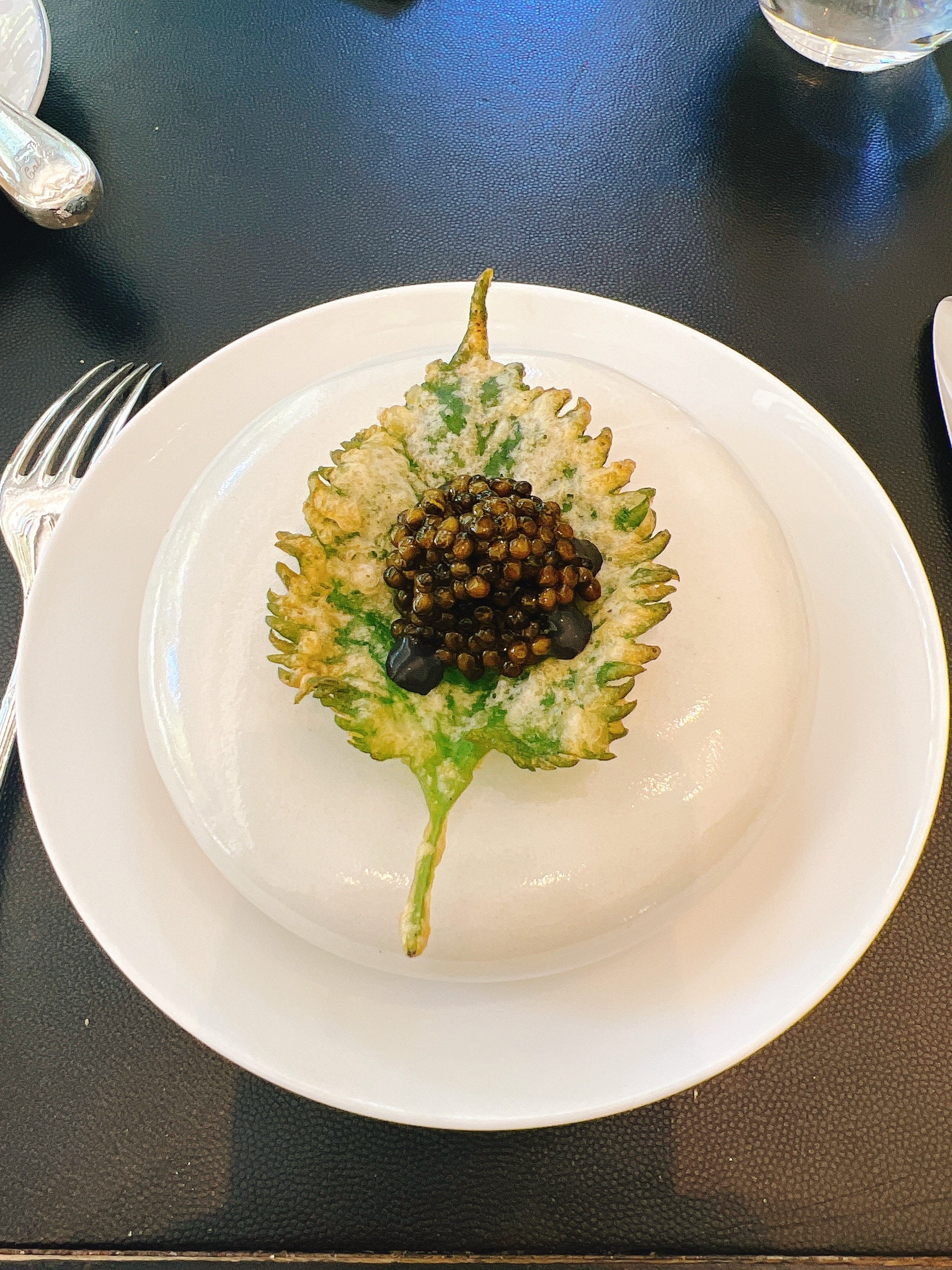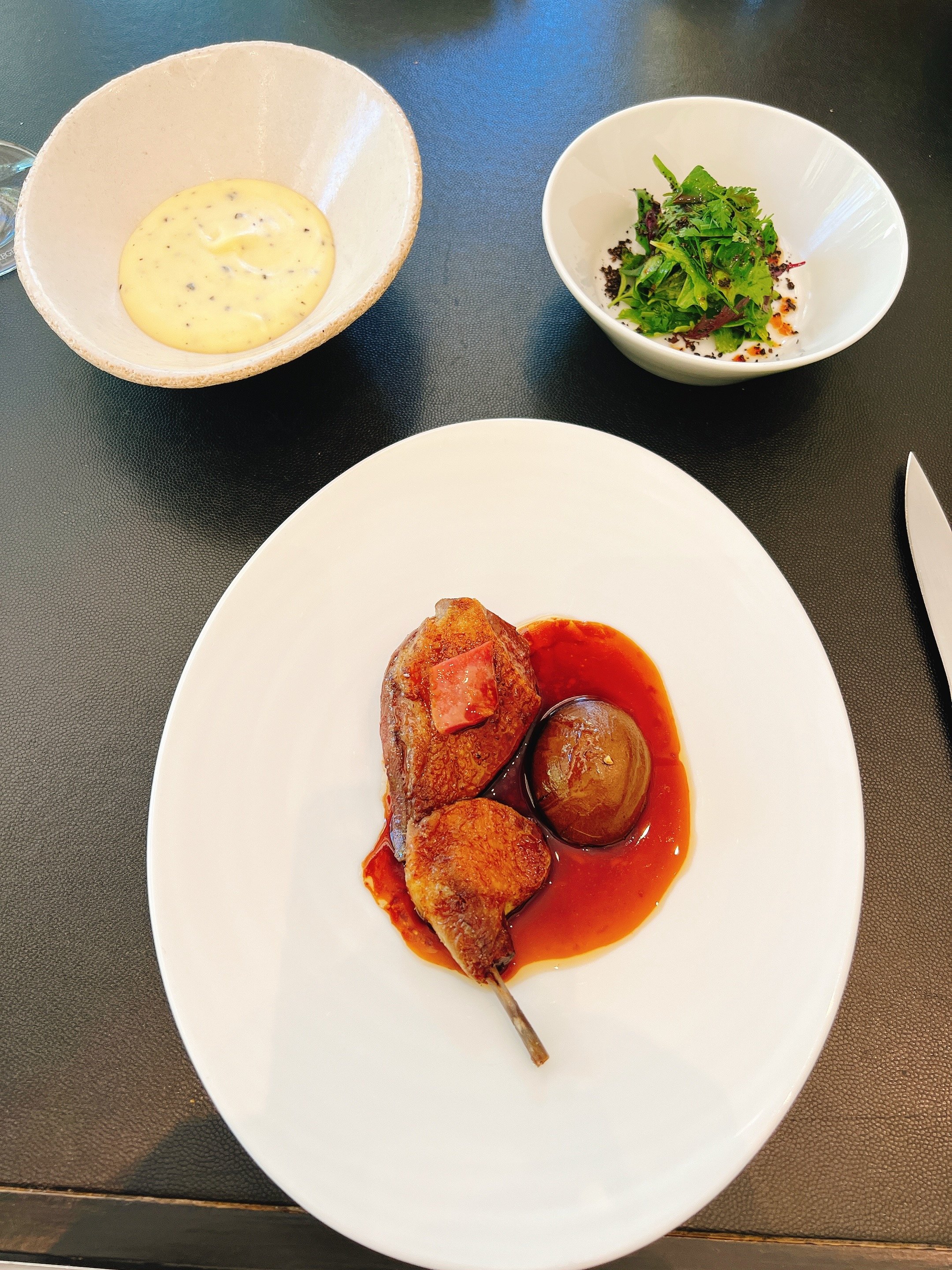Le Pré Catelan - Paris
Rating: 18/20
Where: Paris, France
When: Lunch for 2 on 8 July 2022
Cost per Person: Tasting menu 260-330 Euro
Accolades: 3 Michelin Stars
Why: French cuisine that packs lots of flavor, giving center-stage to individual ingredients; beautiful setting in a park
Le Pré Catelan is located in a small castle in the middle of the expansive Bois de Boulogne park in Paris. It's the least central of the three-star Michelin restaurants in Paris, and dining here while looking out onto the verdant grounds, one does not feel to be in a large city. The building that the restaurant occupies stems from the 19th century, and the main dining room has a decor to match. We ate in a slightly more modern annex, situated right next to the original dining room. The lunch service was almost fulled booked, with around 15 tables.
This restaurant appears to fly a bit under the radar, maybe due to its relatively remote location, or because its chef does not have the empire of restaurants that the likes of Pierre Gagnaire or Guy Savoy command. Whatever the reason, getting a reservation here was very easy compared to Paris' other three-star venues. But any worries that “easy to reserve” might mean “not as good” were quickly dispelled.
Our lunch started with a single bread stick: light, airy, crunchy and with a great cheese flavor. Not the amuse bouche one might expect, but very nice otherwise 18. It was followed by bread: a simple wheat bread, served piping hot and with a perfect crust, it went amazing with the lovely salted butter on the side 18. It's somewhat uncommon these days to receive not just one, but two servings of bread even before the first course. Dangerous especially when the bread is as good as this one - we had to pace ourselves.
Speaking of courses, we had three choices for our Friday. A prix fixe menu of three courses (150 Euro), and two tasting menus of either ten or thirteen courses (260 and 330 Euro, respectively). We went for the longest menu, but in hindsight the ten course menu contained all the biggest hits, so it wouldn't have been a bad choice either. No wine pairings were offered, but the sommelier recommended a bottle of white Burgundy and later a glass of red wine for the solitary meat course.
The first two courses were served side-by-side and had some visual similarities, both dishes resembling avocados in shape, with the "pit" being the edible part. To emphasize that point, the second dish was served in an actual hollowed-out avocado skin.
But in order: our first course was a "piperade", a saucy mix of red peppers, tomatoes, anchovies and olive oil, topped by a stracciatella foam and served in a cracker shell. It was a "flavor bomb", as my wife put it. Bursting with fruity flavor, the red pepper and tomato were in the foreground; the foam and anchovy played only supporting roles. An auspicious beginning 19.
The second dish was eggplant topped with an avocado cream and a decorative amount of caviar. This tasted similar to baba ghanoush, and was much heavier than its sibling course. Again full of strong flavors, but here they were more woodsy, with the eggplant clearly dominating. It’s always impressive to have early courses take an all-or-nothing approach to big flavors and succeeding 19.
Course three was crab served as a flan full of crab meat, and topped with a "dashi" seasoned with star anise. The texture of this dish was a bit like chawanmushi, with a delicious (and again strong) crab flavor. The "dashi" was actually a cream sauce, and not something one would mistake for the traditional Japanese version. That nitpick aside, this was another delicious dish 19.
A veloute of lobster - foamy on top - came next, and we were instructed to drink it like an espresso. Served very hot, this had a strong, lovely lobster flavor, about as good as a lobster soup can be 19. This course turned out to be a gift from the kitchen, so we ended up with a total of fourteen courses.
The regular menu continued with a rouille, a mayonnaisey sauce with saffron that was served with a seafood broth and raw almonds. This dish tasted like the essence of a bouillabaisse, with great fish and saffron flavors, and the almonds contributing a welcome crunchy texture to an otherwise saucy dish. Very big in flavor, this dish's only fault was that it was way too salty (and this is from someone who generally loves salt). Very good, but with some room for improvement 18.
Next came a tempura-fried shiso leaf, topped with barigoule (a sauce based on artichoke juice) and a generous dollop of caviar. On the positive side, the caviar was excellent, adding just the right amount of saltiness to the dish. But the tempura was a bit oily, and the shiso flavor was close to undetectable, making this really just generic crunchy tempura. But, oh, the caviar 17.
A langoustine ravioli was served next, topped with a foie gras emulsion and a jelly containing gold flakes. The langoustine was cooked very well, with a soft but otherwise great texture. Tastewise however, the foie gras overwhelmed the more subtle seafood. By itself the foie gras was tasty, but also hearty and heavy - I wondered whether making it a tad lighter, or adding some acidity, would have resulted in a more harmonious marriage with the langoustine 18.
The next dish was called "cod", but was actually mostly mashed potatoes with some other ingredients, such as a soft boiled egg, garlic, fried onions, and, yes, cod. Great mashed potatoes, but the fish flavor was very subtle 17.
"Salmon" was a more aptly named dish. Calling it "salmon with a wasabi cream sauce" would have been even more accurate, but would still undersell the dish a lot. The wasabi sauce was pretty light, with only a little spice kick, and actually tasted more of horseradish than wasabi. But it was a perfect complement to the utterly amazing salmon. Taken from the core of the salmon, the filet was first cooked for 2-2 1/2 hours at 40 degrees Celsius, then smoked with cherrywood for the same amount of time, and finally salted to create a confit. The result looks almost raw, but melts in the mouth, with just the right amount of smokiness. Perfect 20.
The following course was caviar served on top of a champagne sorbet. This dish could almost be considered a palate cleanser. The combination was unusual, the caviar again really good - earthy and salty -, but the sorbet was very, very sweet. When tasting this dish, the experience ran the gamut from sweet to salty over the course of a few seconds, by having the sorbet melt away and leaving the caviar behind. I was a bit torn about this dish, it definitely worked better than this flavor combination should have any right to, which is quite an accomplishment. But I would probably have preferred to have the caviar just by itself 18.
Pigeon was the meat in the final savory course. This course was served on three plates. The first and largest plate contained roasted pigeon with a mousse of cognac, chicken liver and foie gras. Not surprisingly, this was a very heavy dish, both in terms of calories as in taste. The pigeon was on the heavy, gamey side, and the foie gras mousse was too rich for my taste. To be fair, the dish was well executed for what it was, I just wasn't a fan (16 for this plate). On a separate plate was a salad dressed with pigeon jus and truffles. Very nice and light, it was much better than the main dish (18). And finally, a bowl containing mashed potatoes with truffles. OMG!!! These were some of the best mashed potatoes I've ever had (20). Given that the pigeon was the main attraction here, this averages out to something like 17.
The pescatarian replacement for the pigeon was a John Dory with a beurre blanc sauce. This dish was much, much lighter, the beurre blanc livened up by some lemon flavors. The fish might have been a tad overcooked, but otherwise very lovely 18.
Cheese arrived in the form of a steamed souffle surrounded by a sauce made from 18 month aged Comte cheese. For good measure, it was topped by a slice of black truffle. The cheese sauce was brilliant, but the souffle and black truffle provided more texture than flavor 18.
Commencing the sweet part of our lunch, a biscuit was topped with honey ice cream, a lemony mousse and bee pollen. The biscuit had a good crunch, and overall this dessert wasn't too sweet. Bee pollen is a difficult ingredient to incorporate in dishes (see my not so happy experience in Reims the previous year). Here, however, there was so little of it that it worked fairly well 17.
A chocolate torte made from 65% Mexican chocolate was the final dessert. On the side, it was accompanied by a pistachio ice cream topped with caramelized pistachios. The cake was great, and not too sweet, but like most chocolate desserts, somewhat heavy. (As our server put it - this is not a restaurant you'd choose if you were on a diet.) The candied pistachios were lovely, and the ice cream ok, but I'm generally not a big fan of pistachio ice cream, so my rating here might be on the lower side 16.
Two more bites to accompany our coffee were a lemon tarte and a chocolate praline. The former had a great crunch and good lemon flavor 18, the latter an excellent hazelnut flavor 19.
Overall: A wonderful lunch, with explosions of flavor in every dish. The chef picks an ingredient for each course and then lets that ingredient take front-and-center stage for the taste experience. The majority of these were amazing, with the salmon in particular being utterly breath-taking. Even the dishes that I didn't appreciate as much, such as the cod or pigeon, were very well executed - so someone else might like them just fine. Overall a high 18. Definitely worth visiting.



















